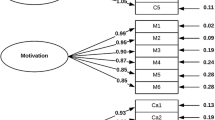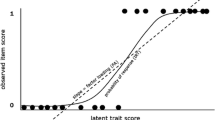Abstract
THE CURRENT INVESTIGATION sought to understand the relationships between college student perception of classroom climate, use of WebCT, and academic achievement. Fifty-three college students provided three categories of predictor and criterion measures: (1) rating scale responses that assessed perception of seven dimensions of classroom climate, (2) four metrics of use of WebCT, and (3) four measures of academic achievement. Results of stepwise regression analyses revealed that dimensions of classroom climate were useful in predicting student achievement and use of WebCT, but in ways that appear unique to hybrid learning environments. Results of backward elimination regression analyses suggested that student use of WebCT was predictive of academic achievement, but in ways that appear unique to hybrid learning environments.
Similar content being viewed by others
References
Al-Bataineh, A., & Brooks, L. (2003). Challenges, advantages, and disadvantages of instructional technology in the community college classroom. Community CollegeJournal of Research and Practice, 27, 473–484.
Allan, E.J., & Madden, M. (2003).Chilly classrooms for female undergraduate students at a research university: A question of method? Paper presented at the Annual Meeting of the American Educational Research Association: Chicago, IL. (ERIC Document Reproduction Service No. ED479384).
Borman, G.D., Hewes, G.M., Overman, L.T. & Brown, S. (2002).Comprehensive school reform and student achievement: A meta-analysis. Baltimore, MD: Center for Research on the Education of Students Placed At Risk. (ERIC Document Reproduction Service No. ED472569).
Burns, B. (1998). Changing the classroom climate with literature circles.Journal of Adolescent & Adult Literacy, 42, 124–29.
Colbeck, C.L., Campbell, S.E. & Bjorklund, S.A. (2000). Grouping in the dark: What college students learn from group projects.Journal of Higher Education, 71, 60–83.
Curtin, J. (2002). WebCT and online tutorials: New possibilities for student interaction.Australian Journal of Educational Technology, 18, 110–26.
Fassinger, P.A. (1995). Understanding classroom interaction: Students’ and professors’ contributions to students’ silence.Journal of Higher Education, 66, 82–96.
Ghaith, G. (2003). The relationship between forms of intruction, achievement and perceptions of classroom climate.Educational Research, 45, 83–93.
Hedberg, J. G. (2003). Ensuring quality e-learning: Creating engaging tasks.Educational Media International, 40, 175–186.
Hirschy, A. S., & Wilson, M.E. (2002). The sociology of the classroom and its influence on student learning.Peabody Journal of Education, 77, 85–100.
Janz, T.A., & Pyke, S.W. (2000). A scale to assess student perceptions of academic climates.Canadian Journal of Higher Education, 30, 89–122.
Joachim, S. (2003). Accentuate the positive: Improving the classroom climate in developmental classes.Research and Teaching in Developmental Education, 19, 65–68.
Johnson, D.W., & Johnson, R.T. (1983). Social interdepencence and perceived academic and personal support within the clasrroom.Journal of Social Psychology, 120, 77–82.
Johnson, G.M., & Howell, A.J. (2005). Attitude toward instructional technology following required vs. optional WebCT usage.Technology and Teacher Education.
Johnson, G.M., Howell, A.J., & Code, J R. (in press). Online discussion and college student learning: Toward a model of influence.Technology, Pedagogy and Education, 14, 61–75.
Kendall, M. (2001). Teaching online to campus-based students: The experience of using WebCT for the community information module at Manchester Metropolitan University.Education for Information, 19, 325–46.
Kerlinger, F.N., & Lee, H.B. (2000).Foundations of behavioral research (4th ed.). Fort Worth, TX: Harcourt.
Kline, T.J.B. (1995). Cooperativeness and competitiveness: Dimensionality and gender specificity of the Classroom Life Instrument.Educational and Psychological Measurement, 55, 335–339.
Lunenburg, F.C., Sartori, M.A., & Bauske, T. (1999).Classroom climate, teacher control behavior, and student self-control: Urban public and military high schools compared. Paper presented at the Annual Meeting of the National Council of Professors of Educational Administration: Jackson Hole, WY. (ERIC Document Reproduction Service No. ED446201).
McNabb, M. (2001). In search of appropriate usage guideline.Learning and Leading with Technology, 29, 50–53.
Marzano, R.J., Pickering, D.J., & Pollock,J.E. (2001).Classroom instruction that works: Research-based strategies for increasing student achievement. Aurora, CO: Mid-Continent Research for Education and Learning. (ERIC Document Reproduction Service No. ED450096).
McArthur, D., Parker, A., & Giersch, S. (2003). Why plan for e-learning?Planning for Higher Education, 31, 20–28.
Miller, H.L. (1997). The New York City Public Schools Integrated Learning Systems Project: Evaluation and meta-evaluation.International Journal of Educational Research, 27, 91–183.
Myers, S.A., & Rocca, K.A. (2001). Perceived instructor argumentativeness and verbal aggressiveness in the college classroom: Effects on student perceptions of climate, apprehension, and state motivation.Western Journal of Communication, 65, 113–37.
Pulvers, K., & Diekhoff, G.M. (1999). The relationship between academic dishonesty and the college classroom environment.Research in Higher Education, 40, 487–498.
Renaud, R. (2003).Test item file for Educational Psychology (2nd Canadian Edition). Toronto, ON: Pearson Education Canada.
Salter, D.W. (2003). Exploring the “chilly classroom” phenomenon as interactions between psychological and environmental types.Journal of College Student Development, 44, 110–21.
van Eijl, P., & Pilot, A. (2003). Using a virtual learning environment in collaborative learning: Criteria for success.Educational Technology, 43, 54–56.
von Rhoneck, C., Grob, K., Schnaitmann, G.W., & Volker, B. (1998). Learning in basic electricity: How do motivation, cognitive and classroom climate factors influence achievement in physics?International Journal of Science Education, 20, 551–65.
WebCT Inc. (2005).WebCT: Learning without limits. Retrieved February 12, 2005, from http://www.webct.com/.
Author information
Authors and Affiliations
Additional information
About the authorGenevieve Marie Johnson received her PhD from the University of Alberta, Canada. She is currently a faculty member in the Department of Psychology and Sociology at Grant MacEwen College. Dr. Johnson’s college teaching is a combination of traditional teaching strategies and online instructional techniques called hybrid learning. Her research agenda focuses on computer facilitation of cognitive and affective factors implicated in human learning.
Rights and permissions
About this article
Cite this article
Johnson, G.M. Perception of classroom climate, use of WebCT, and academic achievement. J. Comput. High. Educ. 17, 25–46 (2006). https://doi.org/10.1007/BF03032697
Issue Date:
DOI: https://doi.org/10.1007/BF03032697




